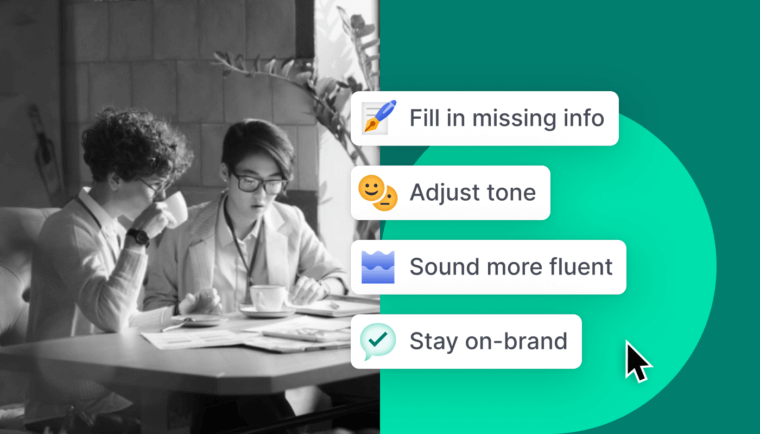
At a time when AI-based communication tools are increasingly prevalent, Grammarly continues to deepen our expertise in evaluating text originality and responsible AI use. We’re launching originality features that combine plagiarism detection, auto-citations, and citation style formatting with newly developed AI detection. These capabilities address the growing need for transparency and accountability in the context of AI-generated content.
A more transparent approach to AI detection
As AI use increases in the workplace and in academic settings, there is a growing need to distinguish between AI and human-generated content. This is particularly relevant in educational settings, where maintaining the integrity of student work is paramount. There are AI detection solutions on the market, but they lack transparency for the writer.
AI detectors are an emerging—and inexact—technology. When an AI detector definitively states whether the analyzed content contains AI, it’s not acting responsibly. No AI detector can conclusively determine whether AI was used to produce text. The accuracy of these tools can vary based on the algorithms used and the text analyzed.
Unfortunately, AI detectors typically aren’t transparent about their limitations and are often deployed only during content review, not before. As a result, writers usually remain in the dark about why their content has been flagged for the presence of AI.
Grammarly does things differently.
Grammarly’s AI detection shows users what part of their text, if any, appears to have been AI-generated, and we provide guidance on interpreting the results. This percentage may not answer “why” text has been flagged. However, it allows the writer to appropriately attribute sources, rewrite content, and mitigate the risk of being incorrectly accused of AI plagiarism. This approach is similar to our plagiarism detection capabilities, which help writers identify and revise potential plagiarism, ensuring the originality and authenticity of their work.
How Grammarly AI detection works
We’re adding AI detection to our originality features as part of our commitment to responsible AI use. We’re prioritizing giving our users, particularly students, as much transparent information as possible, even though the technology has inherent limitations.
When Grammarly checks a document for AI-generated text, it divides it into smaller sections and examines each section for language patterns typical of AI. Grammarly then provides a percentage score for the amount of content that appears to be AI-generated in a document.
There are several reasons text could be flagged for the presence of AI, even when generative AI tools have not been used. For example, a text may exhibit patterns, structures, or characteristics of typical AI-generated content, such as repetitive phrases or unconventional grammar. In addition, AI detectors have been found to be biased against non-native English writers.
We are adding AI detection to our existing academic integrity features, such as the ability to cite generative AI use, to further empower our users. We want to encourage them to make informed decisions about the content they create and incorporate into their writing, cite sources appropriately, and use AI responsibly. AI detection should be part of a holistic approach to evaluating writing originality.
Beyond detection: Grammarly’s holistic suite of originality capabilities
Grammarly encourages a holistic approach to academic integrity and the responsible use of AI. If students prompt Grammarly to compose text during drafting, AI guidelines redirect them to reference their institution’s academic integrity policies and suggest using generative AI as a brainstorming tool. We also offer an AI for Students course, which guides students on any Grammarly plan to use generative AI responsibly, whether it be Grammarly or another tool.
When drafting is complete, Grammarly makes it easy for students to cite their sources. Students can generate properly formatted citations and cite their use of generative AI through one-click “Acknowledge Grammarly gen AI use” prompts. Before an assignment is submitted, students can check their writing for plagiarism against billions of web pages and articles, in addition to now being able to check for the presence of AI-generated text.
Alongside these originality capabilities, Grammarly announced the upcoming release of Grammarly Authorship. Authorship enables users to categorize all text added to their writing assignment automatically. It generates a comprehensive report detailing the content’s origin—human-typed, AI-generated, edited with traditional grammar checking, or sourced externally. This feature complements AI detection, providing writers with detailed and objective information about the likely composition of their text.
Authorship facilitates more productive conversations between students and faculty regarding a student’s writing process. This mitigates some of the more adversarial back-and-forth between professors and students that the education market has seen since the advent of AI tools. Authorship will be available as a beta in Google Docs for all Grammarly customers beginning in September 2024.
Grammarly’s introduction of AI detection and Authorship signifies our dedication to empowering users with holistic tools to support academic integrity. These efforts are essential to ensure that technology augments human effort without diminishing the value of original work, fostering responsible AI use in the classroom and the workplace.






